1988 PONTIAC FIERO light
[x] Cancel search: lightPage 49 of 1825
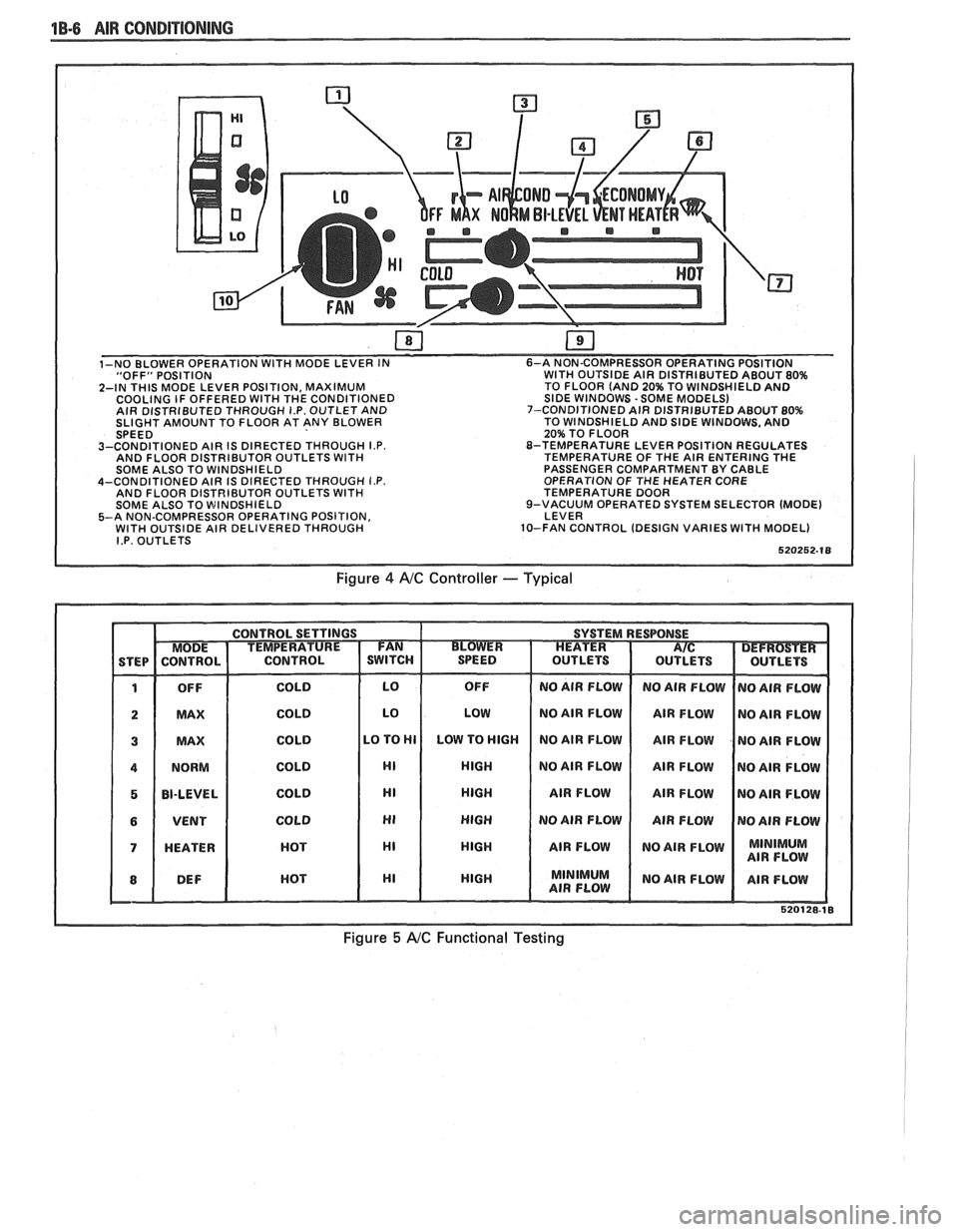
1B-6 AIR CONDlTlONlNC
"OFF" POSITION WITH OUTSIDE AIR DISTRIBUTED ABOUT 80%
2-IN THIS MODE LEVER POSITION, MAXIMUM TO
FLOOR (AND 20% TO WINDSHIELD AND
COOLING IF OFFERED WITH THE CONDITIONED SIDE WINDOWS -SOME MODELS)
AIR DISTRIBUTED THROUGH I.P. OUTLET AND 7-CONDITIONED
AIR DISTRIBUTED ABOUT 80% SLIGHT AMOUNT TO FLOOR AT ANY BLOWER TO
WINDSHIELD AND SIDE WINDOWS, AND
20% TO FLOOR
3-CONDITIONED AIR IS DIRECTED THROUGH
I.P. 8-TEMPERATURE LEVER POSITION REGULATES
AND FLOOR DISTRIBUTOR OUTLETS WITH TEMPERATURE OF THE AIR ENTERING THE
SOME ALSO TO WINDSHIELD PASSENGER
COMPARTMENT BY CABLE
4-CONDITIONED AIR IS DIRECTED THROUGH
I.P. OPERATION OF THE HEATER CORE
AND FLOOR DISTRIBUTOR OUTLETS WITH TEMPERATURE DOOR
SOME ALSO TO WINDSHIELD 9-VACUUM
OPERATED SYSTEM SELECTOR (MODE)
5-A NON-COMPRESSOR OPERATING POSITION, LEVER
WITH OUTSIDE AIR DELIVERED THROUGH 10-FAN CONTROL
(DESIGN VARIES WITH MODEL) I.P. OUTLETS
Figure 4 AIC Controller -- Typical
Figure 5 A/C Functional Testing
Page 59 of 1825
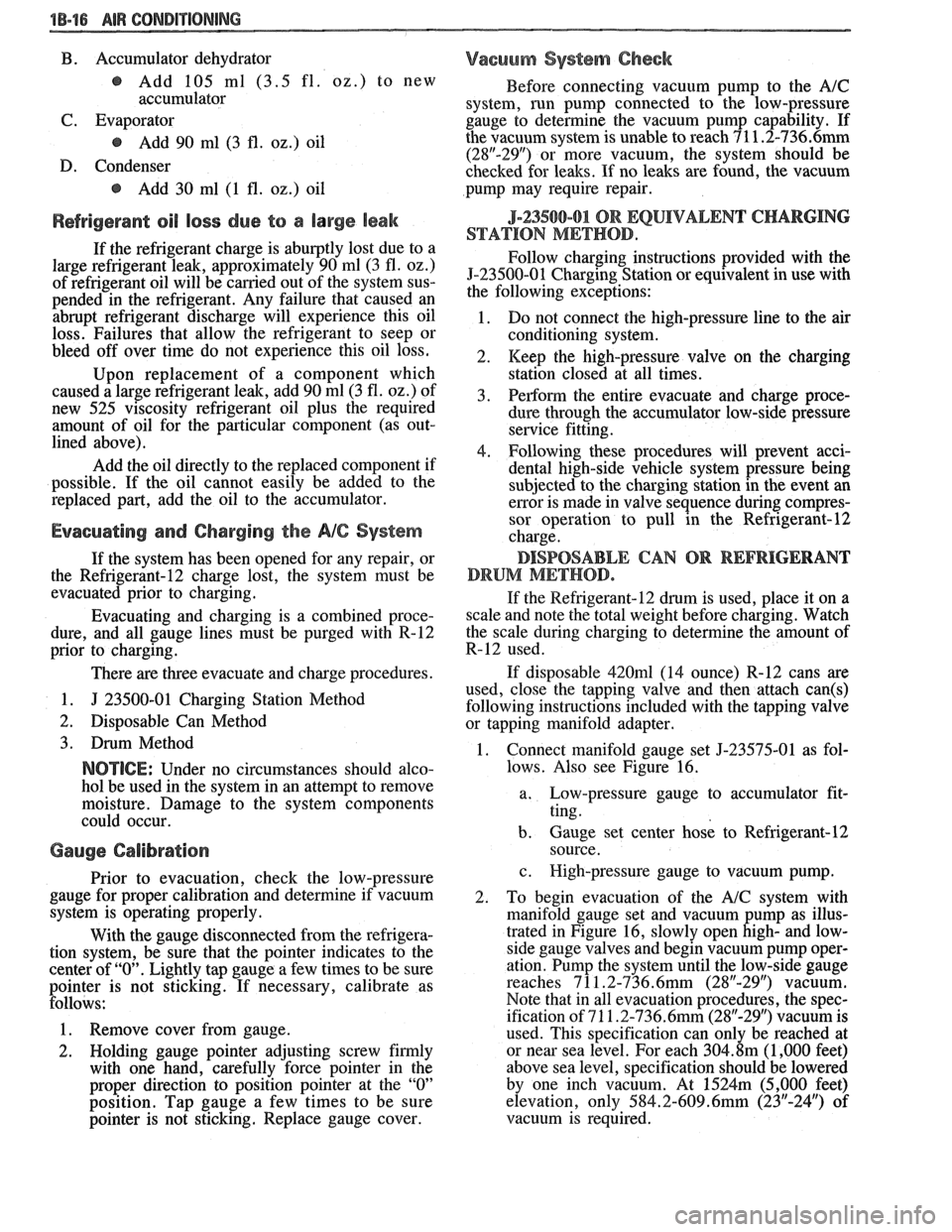
"18-16 AIR CONDITIONING
B . Accumulator dehydrator
@ Add 105 ml (3.5 fl. 02.) to new
accumulator
C. Evaporator
@ Add 90 ml (3 fl. oz.) oil
D. Condenser
@ Add 30 ml (1 fl. 02.) oil
Refrigerant oil loss due to a large leak
If the refrigerant charge is aburptly lost due to a
large refrigerant leak, approximately 90
ml (3 fl. oz.)
of refrigerant oil will be
carried out of the system sus-
pended in the refrigerant. Any failure that caused an
abrupt refrigerant discharge will experience this oil
loss. Failures that allow the refrigerant to seep or
bleed off over time do not experience this oil loss.
Upon replacement of a component which
caused a large refrigerant leak, add 90 ml(3
fl. oz.) of
new 525 viscosity refrigerant oil plus the required
amount of oil for the particular component (as out-
lined above).
Add the oil directly to the replaced component if
possible. If the oil cannot easily be added to the
replaced part, add the oil to the accumulator.
Evacuating and Charging the A/C System
If the system has been opened for any repair, or
the Refrigerant-12 charge lost, the system must be
evacuated prior to charging.
Evacuating and charging is a combined proce-
dure, and all gauge lines must be purged with R-12
prior to charging.
There are three evacuate and charge procedures.
1.
J 23500-01 Charging Station Method
2. Disposable Can Method 3. Drum Method
NOTICE: Under no circumstances should alco-
hol be used in the system in an attempt to remove
moisture. Damage to the system components
could occur.
Gauge Calibration
Prior to evacuation, check the low-pressure
gauge for proper calibration and determine if vacuum
system is operating properly.
With the gauge disconnected from the refrigera-
tion system, be sure that the pointer indicates to the
center of
"0". Lightly tap gauge a few times to be sure
pointer is not sticking. If necessary, calibrate as
follows:
1. Remove cover from gauge.
2. Holding gauge pointer adjusting screw firmly
with one hand, carefully force pointer in the
proper direction to position pointer at the
"0"
position. Tap gauge a few times to be sure
pointer is not sticking. Replace gauge cover.
Vacuum System Check
Before connecting vacuum pump to the A/C
system, run pump connected to the low-pressure
gauge to determine the vacuum pump capability. If
the vacuum system is unable to reach
7 1 1.2-736.6mm
(28"-29") or more vacuum, the system should be
checked for leaks. If no leaks are found, the vacuum
pump may require repair.
5-23580-81 OR EQUIVALENT CHARGING
STATION METHOD.
Follow charging instructions provided with the
5-23500-01 Charging Station or equivalent in use with
the following exceptions:
1. Do
not connect the high-pressure line to the air
conditioning system.
2. Keep the high-pressure valve on the charging
station closed at all times.
3.
Perform the entire evacuate and charge proce-
dure through the accumulator low-side pressure service fitting.
4. Following these procedures will prevent acci-
dental high-side vehicle system pressure being
subjected to the charging station in the event an
error is made in valve sequence during compres-
sor operation to pull in the Refrigerant-12
charge.
DISPOSABLE CAN OR REFRIGERANT
DRUM METHOD.
If the Refrigerant-12 drum is used, place it on a
scale and note the total weight before charging. Watch
the scale during charging to determine the amount of
R-12 used.
If disposable
420ml (14 ounce) R-12 cans are
used, close the tapping valve and then attach
can(s)
following instructions included with the tapping valve
or tapping manifold adapter.
1. Connect manifold gauge set 5-23575-01 as fol-
lows. Also see Figure 16.
a. Eow-pressure gauge to accumulator fit-
ting.
b. Gauge set center hosk to Refrigerant-12
source.
c. High-pressure gauge to vacuum pump.
2. To begin evacuation of the
A/C system with
manifold gauge set and vacuum pump as illus-
trated in Figure 16, slowly open
high- and low-
side gauge valves and begin vacuum pump oper-
ation. Pump the system until the low-side gauge
reaches 7 1
1.2-736.6mm (28"-29") vacuum.
Note that in all evacuation procedures, the spec-
ification of 7 1
1.2-736.6mm (28"-29") vacuum is
used. This specification can only be reached at
or near sea level. For each
304.8m (1,000 feet)
above sea level, specification should be lowered
by one inch vacuum. At
1524m (5,000 feet)
elevation, only
584.2-609.6mm (23"-24") of
vacuum is required.
Page 83 of 1825
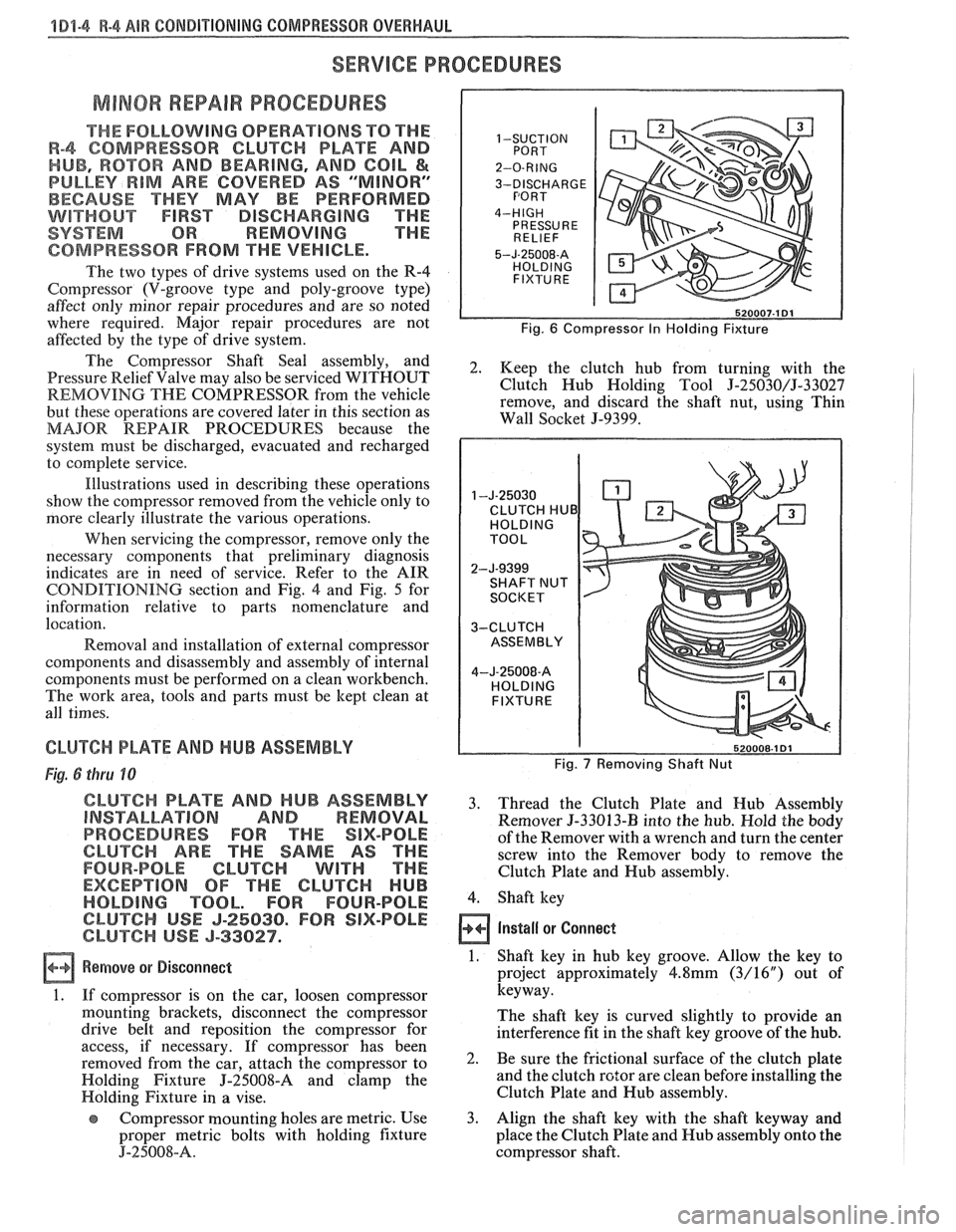
181-4 R-4 ABR CONDITIONING COMPRESSOR OVERHAUL
SERVICE PROCEDURES
MINOR REPAIR PROCEDURES
THE FOLLOWING OPERATIONS TO THE
R-4 COMPRESSOR CLUTCH PLATE AND 1 -SUCTION
HUB, ROTOR AND BEARING, AND COIL &
PULLEY RIM ARE COVERED AS 'WINOR" 3-DISCHARGE
BECAUSE THEY MAY BE PERFORMED
WITHOUT FIRST DISCHARGING THE
SYSTEM OR REMOVING THE
COMPRESSOR FROM THE VEHICLE. 5-~-25008-~
The two types of drive systems used on the R-4
Compressor (\I-groove type and poly-groove type)
affect only minor repair procedures and are so noted
where required. Major repair procedures are not
Fig. 6 Compressor In Holding Fixture affected by the type of drive system.
The Shaft and 2. Keep the clutch hub from turning with the
Pressure Relief Valve may also be serviced WITHOUT
REMOVING THE COMPRESSOR from the vehicle Clutch
Hub Holding Tool 5-25030/J-33027
remove, and discard the shaft nut, using Thin
but these operations are covered later in this section as
MAJOR REPAIR PROCEDURES because the Wall Socket
5-9399.
system must be discharged, evacuated and recharged
to complete service.
Illustrations used in describing these operations
show the compressor removed from the vehicle only to
more clearly illustrate the various operations.
CLUTCH HUB
When servicing the compressor, remove only the
necessary components that preliminary diagnosis
indicates are in need of service. Refer to the AIR
CONDITIONING section and Fig.
4 and Fig. 5 for
information relative to parts nomenclature and
location.
Removal and installation of external compressor
components and disassembly and assembly of internal
components must be performed on a clean workbench.
The work area, tools and parts must be kept clean at
all times.
CLUTCH PLATE AND HUB ASSEMBLY Fig. 7 Removing Shaft Nut Fig. 6 thru 10
CLUTCH PLATE AND HUB ASSEMBLY 3. Thread the Clutch Plate and Hub Assembly INSTALLATION AND REMOVAL Remover 5-33013-I3 into the hub. Hold the body
PROCEDURES FOR THE SIX-POLE of the Remover with a wrench and turn the center
CLUTCH ARE THE SAME AS THE screw into the Remover body to remove the
FOUR-POLE CLUTCH WITH THE Clutch Plate and Hub assembly.
EXCEPTION OF THE CLUTCH HUB
HOLDING TOOL. FOR FOUR-POLE 4. Shaft key
CLUTCH USE J-25030. FOR SIX-POLE
CLUTCH USE J-33027. Install or Connect
a Remove or Disconnect 1. Shaft key in hub key groove. Allow the key to
project approximately
4.8mm (3/16") out of
1. If compressor is on the car, loosen compressor keyway.
mounting brackets, disconnect the compressor
The shaft key is curved slightly to provide an
drive belt and reposition the compressor for
interference fit in the shaft key groove of the hub.
access, if necessary. If compressor has been
removed from the car, attach the compressor to 2. Be Sure the frictional surface of the clutch plate
Holding Fixture
J-'25008-8 and clamp the and
the clutch rotor are clean before installing the
Holding Fixture
in a vise. Clutch
Plate and Hub assembly.
Compressor mounting holes are metric. Use 3.
Align the shaft key with the shaft keyway and
proper metric bolts with holding fixture place the Clutch Plate and Hub assembly onto the
J-25008-A. compressor shaft.
Page 103 of 1825
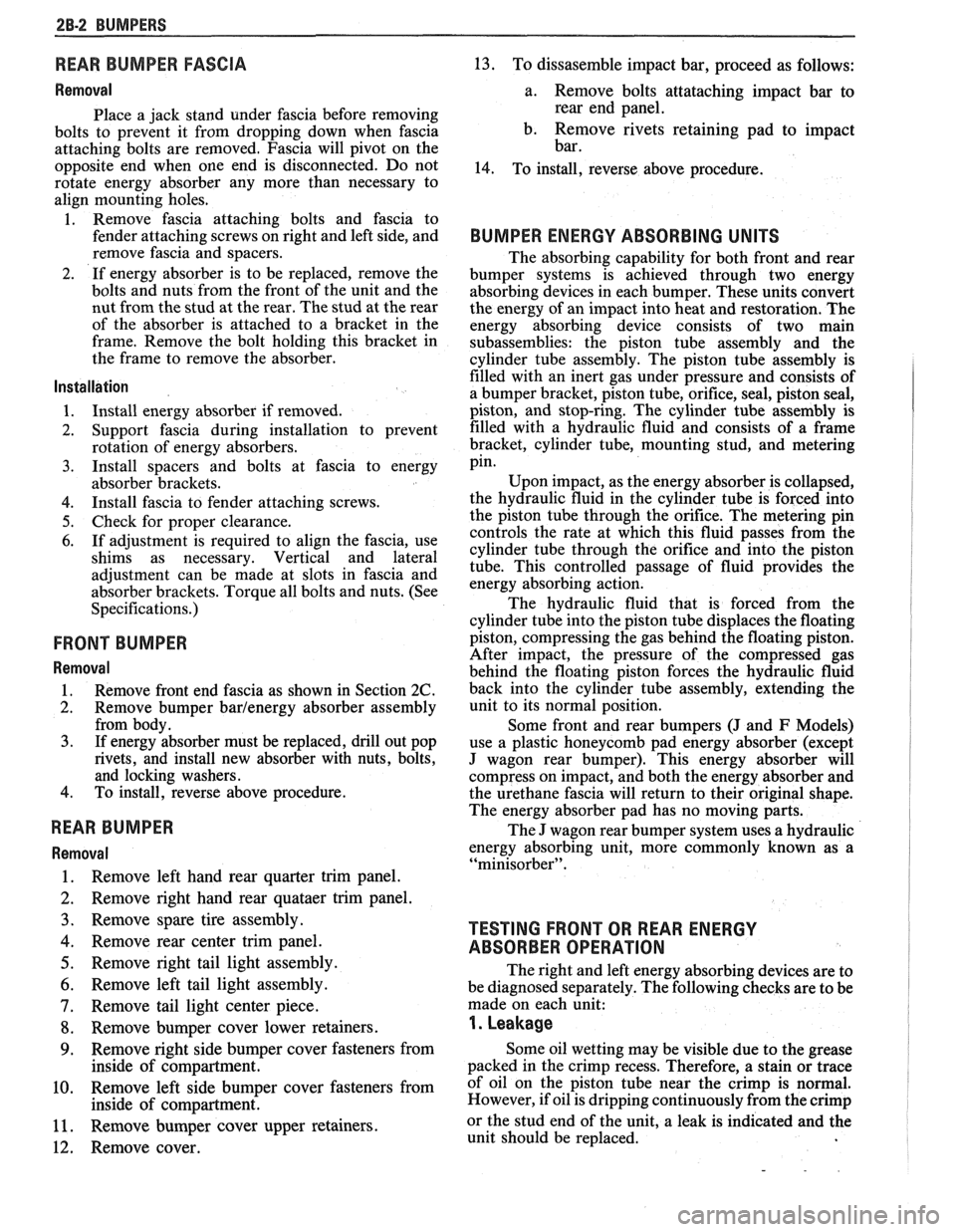
2B-2 BUMPERS
REAR BUMPER FASCIA
Removal
Place a jack stand under fascia before removing
bolts to prevent it from dropping down when fascia
attaching bolts are removed. Fascia will pivot on the
opposite end when one end is disconnected. Do not
rotate energy absorber any more than necessary to
align mounting holes.
1. Remove fascia attaching bolts and fascia to
fender attaching screws on right and left side, and
remove fascia and spacers.
2. If energy absorber is to be replaced, remove the
bolts and nuts from the front of the unit and the
nut from the stud at the rear. The stud at the rear
of the absorber is attached to a bracket in the
frame. Remove the bolt holding this bracket in
the frame to remove the absorber.
Installation
1. Install energy absorber if removed.
2. Support fascia during installation to prevent
rotation of energy absorbers.
3. Install spacers and bolts at fascia to energy
absorber brackets.
4. Install fascia to fender attaching screws.
5. Check for proper clearance.
6. If adjustment is required to align the fascia, use
shims as necessary. Vertical and lateral
adjustment can be made at slots in fascia and
absorber brackets. Torque all bolts and nuts. (See
Specifications.)
FRONT BUMPER
Removal
1. Remove
front end fascia as shown in Section 2C.
2. Remove bumper barlenergy absorber assembly
from body.
3. If energy absorber must be replaced, drill out pop
rivets, and install new absorber with nuts, bolts,
and locking washers.
4. To install, reverse above procedure.
REAR BUMPER
Removal
1. Remove left hand rear quarter trim panel.
2. Remove right hand rear quataer trim panel.
3. Remove spare tire assembly.
4. Remove rear center trim panel.
5. Remove right tail light assembly.
6. Remove left tail light assembly.
7. Remove tail light center piece.
8. Remove bumper cover lower retainers.
9. Remove right-side bumper cover fasteners from
inside of compartment.
10. Remove left side bumper cover fasteners from
inside of compartment.
11. Remove bumper cover upper retainers.
12. Remove cover.
13. To dissasemble impact bar, proceed as follows:
a. Remove bolts attataching impact bar to
rear end panel.
b. Remove rivets retaining pad to impact
bar.
14. To install, reverse above procedure.
BUMPER ENERGY ABSORBING UNITS
The absorbing capability for both front and rear
bumper systems is achieved through two energy
absorbing devices in each bumper. These units convert
the energy of an impact into heat and restoration. The
energy absorbing device consists of two main
subassemblies: the piston tube assembly and the
cylinder tube assembly. The piston tube assembly is
filled with an inert gas under pressure and consists of
a bumper bracket, piston tube, orifice, seal, piston seal,
piston, and stop-ring. The cylinder tube assembly is
filled with a hydraulic fluid and consists of a frame
bracket, cylinder tube, mounting stud, and metering
pin.
Upon impact, as the energy absorber is collapsed,
the hydraulic fluid in the cylinder tube is forced into
the piston tube through the orifice. The metering pin
controls the rate at which this fluid passes from the
cylinder tube through the orifice and into the piston
tube. This controlled passage of fluid provides the
energy absorbing action.
The hydraulic fluid that is forced from the
cylinder tube into the piston tube displaces the floating
piston, compressing the gas behind the floating piston.
After impact, the pressure of the compressed gas
behind the floating piston forces the hydraulic fluid
back into the cylinder tube assembly, extending the
unit to its normal position.
Some front and rear bumpers (J and
F Models)
use a plastic honeycomb pad energy absorber (except
J wagon rear bumper). This energy absorber will
compress on impact, and both the energy absorber and
the urethane fascia will return to their original shape.
The energy absorber pad has no moving parts.
The J wagon rear bumper system uses a hydraulic
energy absorbing unit, more commonly known as a
"minisorber".
TESTING FRONT OR REAR ENERGY
ABSORBER OPERATION
The right and left energy absorbing devices are to
be diagnosed separately. The following checks are to be
made on each unit:
1. Leakage
Some oil wetting may be visible due to the grease
packed in the crimp recess. Therefore, a stain or trace
of oil on the piston tube near the crimp is normal.
However, if oil is dripping continuously from the crimp
or the stud end of the unit, a leak is indicated and the
unit should be replaced.
Page 110 of 1825
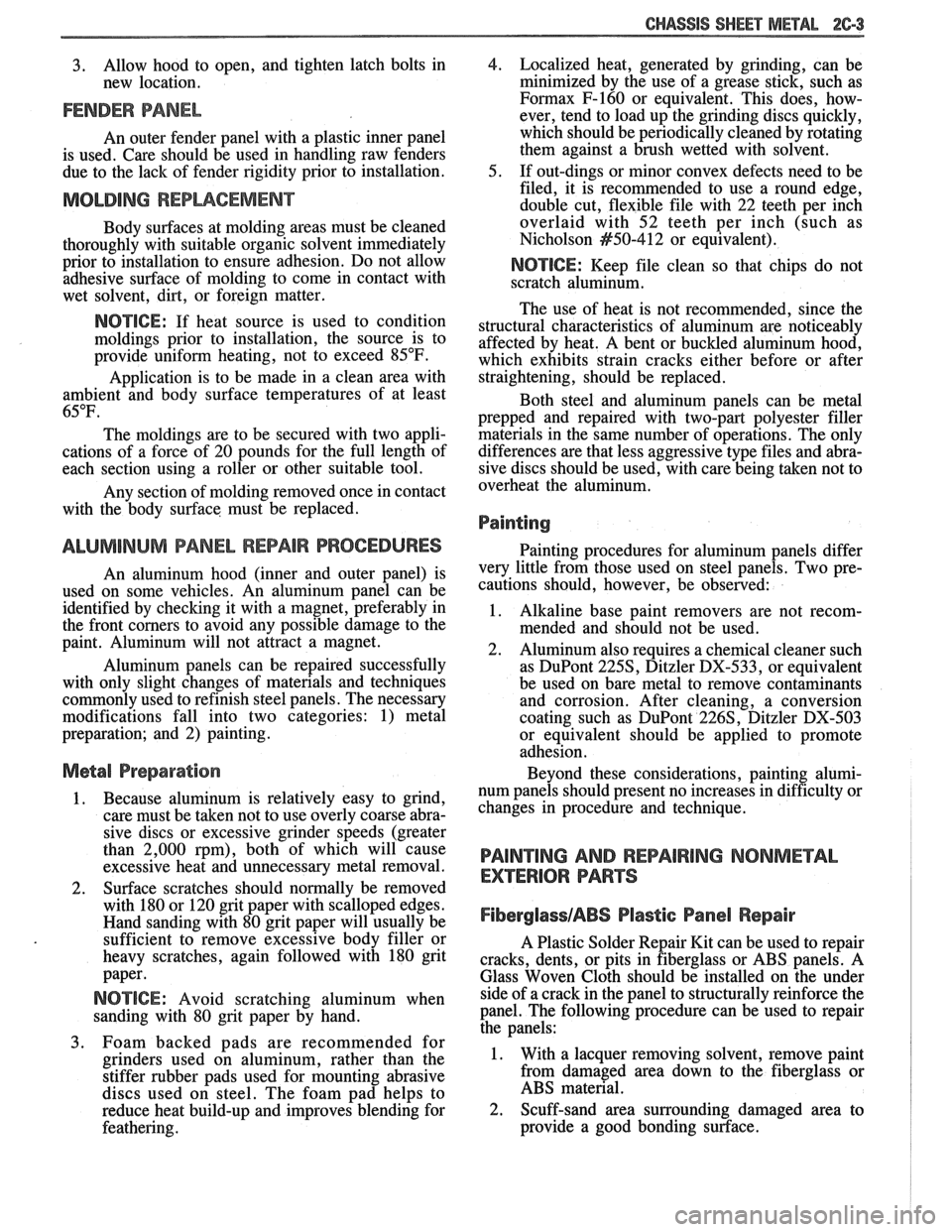
CHASSIS SHEET METAL 2C-3
3. Allow hood to open, and tighten latch bolts in
new location.
FENDER PANEL
An outer fender panel with a plastic inner panel
is used. Care should be used in handling raw fenders
due to the lack of fender rigidity prior to installation.
Body surfaces at molding areas must be cleaned
thoroughly with suitable organic solvent immediately
prior to installation to ensure adhesion. Do not allow
adhesive surface of molding to come in contact with
wet solvent, dirt, or foreign matter.
NO"FICE: If heat source is used to condition
moldings prior to installation, the source is to
provide
uniform heating, not to exceed 85°F.
Application is to be made in a clean area with
ambient and body surface temperatures of at least
65°F.
The moldings are to be secured with two appli-
cations of a force of 20 pounds for the full length of
each section using a roller or other suitable tool.
Any section of molding removed once in contact
with the body surface must be replaced.
ALUMINUM PANEL REPAIR PROCEDURES
An aluminum hood (inner and outer panel) is
used on some vehicles. An aluminum panel can be
identified by checking it with a magnet, preferably in
the front corners to avoid any possible damage to the
paint. Aluminum will not attract a magnet.
Aluminum panels can be repaired successfully
with only slight changes of materials and techniques
commonly used to refinish steel panels. The necessary
modifications fall into two categories: 1) metal
preparation; and 2) painting.
Metal Preparation
1. Because aluminum is relatively easy to grind,
care must be taken not to use overly coarse abra-
sive discs or excessive grinder speeds (greater
than 2,000 rpm), both of which will cause
excessive heat and unnecessary metal removal.
2. Surface scratches should normally be removed
with 180 or 120 grit paper with scalloped edges.
Hand sanding with 80 grit paper will usually be
sufficient to remove excessive body filler or
heavy scratches, again followed with 180 grit
paper.
NOTICE: Avoid scratching aluminum when
sanding with 80 grit paper by hand.
3. Foam backed pads are recommended for
grinders used on aluminum, rather than the
stiffer rubber pads used for mounting abrasive
discs used on steel. The foam pad helps to
reduce heat build-up and improves blending for
feathering.
4. Localized heat, generated by grinding, can be
minimized by the use of a grease stick, such as
Formax F-160 or equivalent. This does, how-
ever, tend to load up the grinding discs quickly,
which should be periodically cleaned by rotating
them against a brush wetted with solvent.
5. If out-dings or minor convex defects need to be
filed, it is recommended to use a round edge,
double cut, flexible file with 22 teeth per inch
overlaid with 52 teeth per inch (such as
Nicholson
#50-412 or equivalent).
NOTICE: Keep file clean so that chips do not
scratch aluminum.
The use of heat is not recommended, since the
structural characteristics of aluminum are noticeably
affected by heat. A bent or buckled aluminum hood,
which exhibits strain cracks either before or after
straightening, should be replaced.
Both steel and aluminum panels can be metal
prepped and repaired with two-part polyester filler
materials in the same number of operations. The only
differences are that less aggressive type files and abra- sive discs should be used, with care being taken not to
overheat the aluminum.
Painting
Painting procedures for aluminum panels differ
very little from those used on steel panels. Two pre-
cautions should, however, be observed:
1. Alkaline base paint removers are not recom-
mended and should not be used.
2. Aluminum also requires a chemical cleaner such
as
DuPont 2253, Ditzler DX-533, or equivalent
be used on bare metal to remove contaminants
and corrosion. After cleaning, a conversion
coating such as DuPont
226S, Ditzler DX-503
or equivalent should be applied to promote
adhesion.
Beyond these considerations, painting alumi-
num panels should present no increases in difficulty or
changes in procedure and technique.
PAINTING AND REPAIRING NONMETAL
EXTERIOR PARTS 1
FiberglassIABS Plastic Panel Repair ~
A Plastic Solder Repair Kit can be used to repair
cracks, dents, or pits in fiberglass or ABS panels. A
Glass Woven Cloth should be installed on the under
side of a crack in the panel to structurally reinforce the
panel. The following procedure can be used to repair
the panels:
1. With a lacquer removing solvent, remove paint
from damaged area down to the fiberglass or
, ABS material. I
2. Scuff-sand area surrounding damaged area to
provide a good bonding surface.
Page 111 of 1825
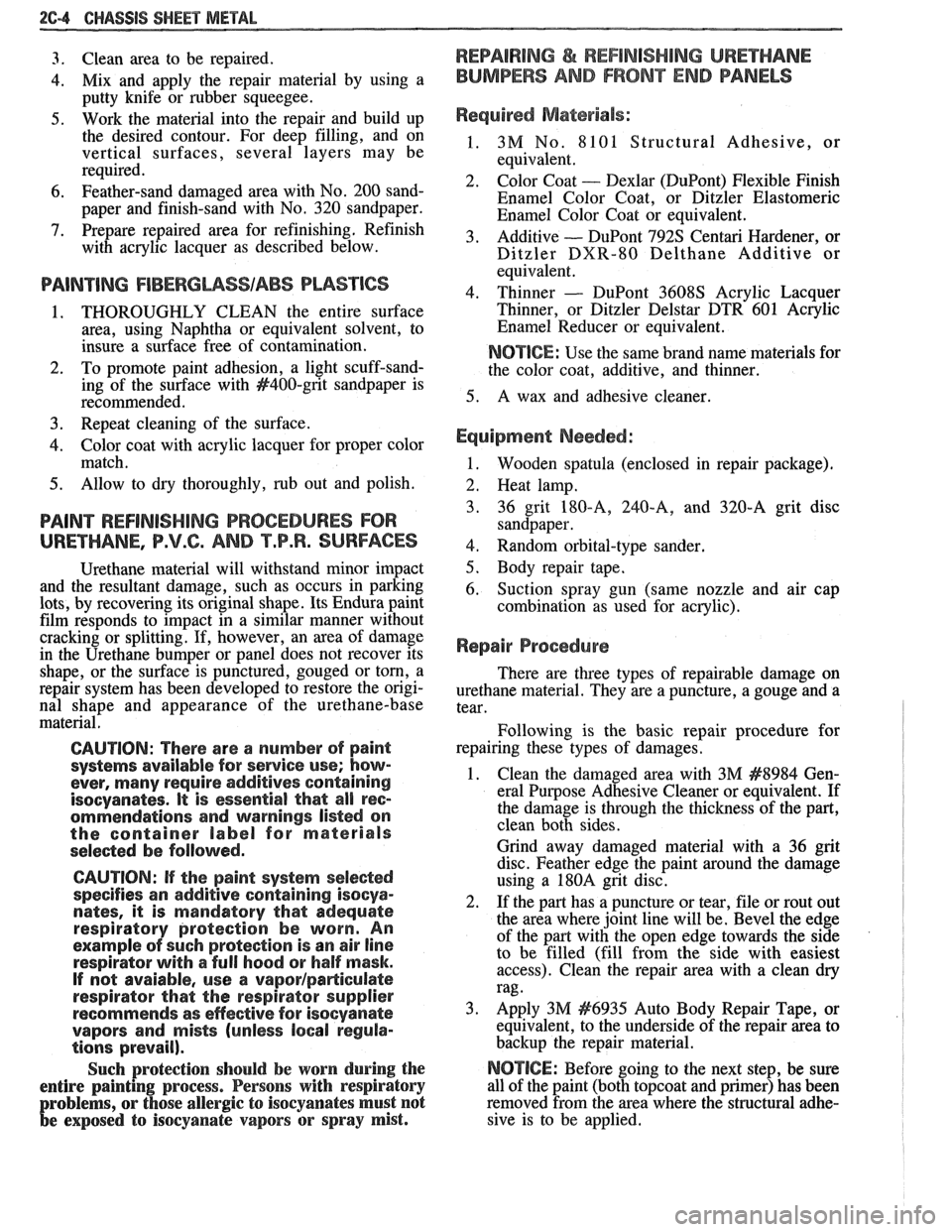
2C-4 CHASSIS SHEET METAL
3. Clean area to be repaired.
4. Mix and apply the repair material by using a
putty knife or rubber squeegee.
5. Work the material into the repair and build up
the desired contour. For deep filling, and on
vertical surfaces, several layers may be
required.
6. Feather-sand damaged area with No. 200 sand-
paper and finish-sand with No. 320 sandpaper.
7. Prepare repaired area for refinishing. Refinish
with acrylic lacquer as described below.
1. THOROUGHLY CLEAN the entire surface
area, using Naphtha or equivalent solvent, to
insure a surface free of contamination.
2. To promote paint adhesion, a light scuff-sand-
ing of the surface with
#400-grit sandpaper is
recommended.
3. Repeat cleaning of the surface.
4. Color coat with acrylic lacquer for proper color
match.
5. Allow to dry thoroughly, rub out and polish.
PAINT REFINISHING PROCEDURES FOR
URETHANE, P.V.C. AND T.P.R. SURFACES
Urethane material will withstand minor impact
and the resultant damage, such as occurs in parking
lots, by recovering its original shape. Its Endura paint
film responds to impact in a similar manner without
cracking or splitting. If, however, an area of damage
in the Urethane bumper or panel does not recover its
shape, or the surface is punctured, gouged or torn, a
repair system has been developed to restore the origi-
nal shape and appearance of the urethane-base
material.
CALSVON: There are a number of paint
systems available For service use; how-
ever,
many require additives containing
isocyanates.
It is essential that all rec-
ommendations and warnings listed on
the container label for
materials
seleded be followed.
CAUTION: If the paint system selected
specifies an additive containing
isocya-
nates, it is mandatory that adequate
respiratory protection be worn. An
example of such protection
is an air line
respirator with a
full hood or half mask.
If not
avaiable, use a vaporlpaHiculate
respirator that the respirator supplier
recommends as
efFective for isocyanate
vapors and mists (unless local
regula-
tions prevail).
Such protection should be worn during the
entire painting process. Persons with respiratory
problems, or those
allergic to isocyanates must not
be exposed to isocyanate vapors or spray mist.
REPAIRING & REFINISHING URETHANE
BUMPERS AND FRONT END PANELS
Required Materials:
1. 3M No. 8101 Structural Adhesive, or
equivalent.
2. Color Coat - Dexlar (DuPont) Flexible Finish
Enamel Color Coat, or Ditzler Elastomeric
Enamel Color Coat or equivalent.
3. Additive
- DuPont 792s Centari Hardener,
or
Ditzler
DXR-80 Delthane Additive or
equivalent.
4. Thinner
- DuPont 3608s Acrylic
Lacquer
Thinner, or Ditzler Delstar DTR 601 Acrylic
Enamel Reducer or equivalent.
NOTICE: Use the same brand name materials for
the color coat, additive, and thinner.
5. A wax and adhesive cleaner.
Equipment Needed:
1. Wooden spatula (enclosed in repair package).
2. Heat lamp.
3. 36 grit 180-A, 240-A, and 320-A grit disc
sandpaper.
4. Random orbital-type sander.
5. Body repair tape.
6. Suction spray gun (same nozzle and air cap
combination as used for acrylic).
Repair Procedure
There are three types of repairable damage on
urethane material. They are a puncture, a gouge and a
tear.
Following is the basic repair procedure for
repairing these types of damages.
1. Clean the damaged area with 3M #8984 Gen-
eral Purpose Adhesive Cleaner or equivalent. If
the damage is through the thickness of the part,
clean both sides.
Grind away damaged material with a
36 grit
disc. Feather edge the paint around the damage
using a
1808 grit disc.
2. If the part has a puncture or tear, file or rout out
the area where joint line will be. Bevel the edge
of the part with the open edge towards the side
to be filled (fill from the side with easiest
access). Clean the repair area with a clean dry
rag.
3. Apply 3M #6935 Auto Body Repair Tape, or
equivalent, to the underside of the repair area to
backup the repair material.
NOTICE: Before going to the next step, be sure
all of the paint (both topcoat and primer) has been
removed from the area where the structural adhe-
sive is to be applied.
Page 112 of 1825
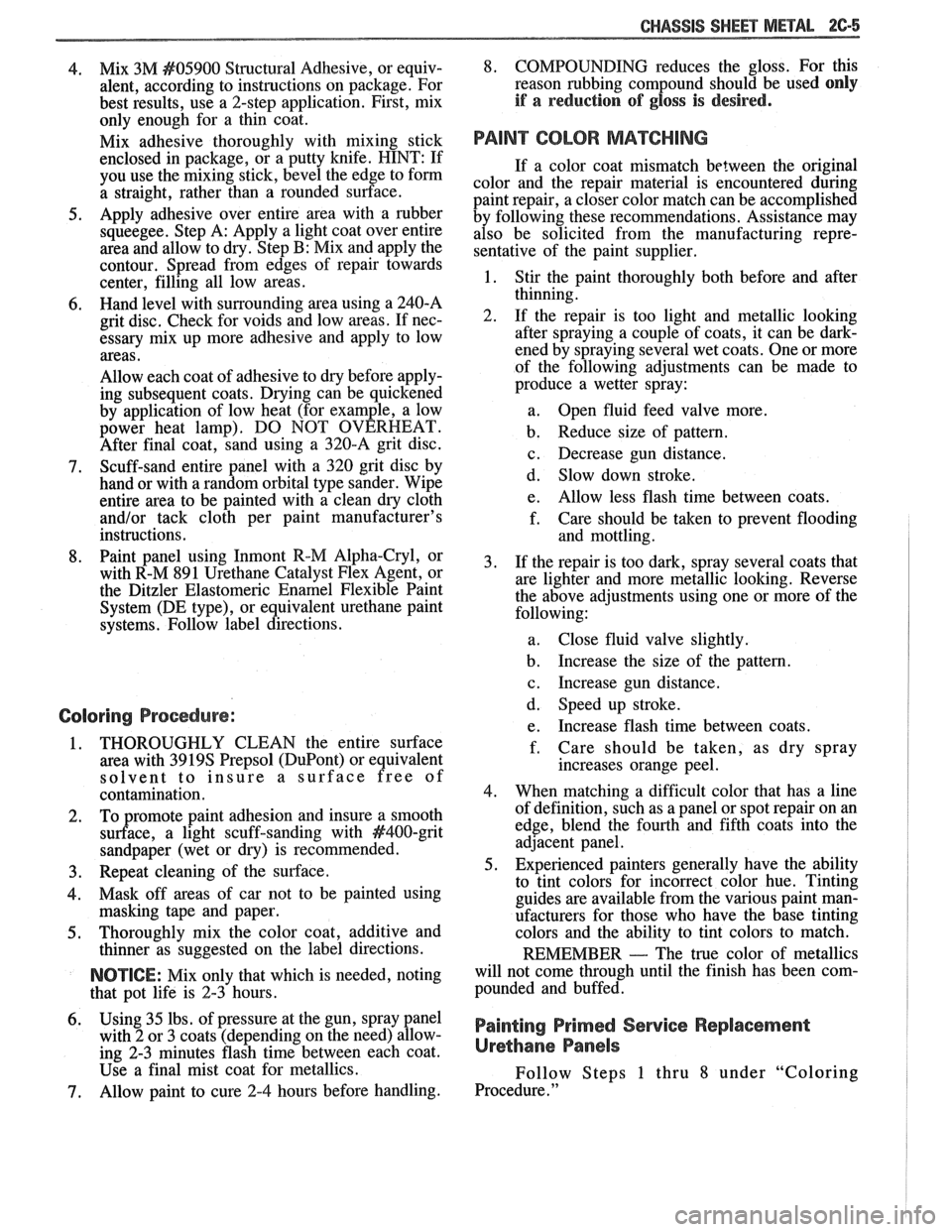
CHASSIS SWEET MEWL 2C-5
4. Mix 3M #05900 Structural Adhesive, or equiv-
alent, according to instructions on package. For
best results, use a 2-step application. First, mix
only enough for a thin coat.
Mix adhesive thoroughly with mixing stick
enclosed in package, or a putty knife. HINT: If
you use the mixing stick, bevel the edge to form
a straight, rather than a rounded surface.
5. Apply adhesive over entire area with a rubber
squeegee. Step A: Apply a light coat over entire
area and allow to dry. Step
B: Mix and apply the
contour. Spread from edges of repair towards
center, filling all low areas.
6. Hand level with surrounding area using a 240-A
grit disc. Check for voids and low areas. If nec-
essary mix up more adhesive and apply to low
areas.
Allow each coat of adhesive to dry before apply-
ing subsequent coats. Drying can be quickened
by application of low heat (for example, a low
power heat lamp). DO NOT OVERHEAT.
After final coat, sand using a 320-A grit disc.
7. Scuff-sand entire panel with a 320 grit disc by
hand or with a random orbital type sander. Wipe
entire area to be painted with a clean dry cloth
and/or tack cloth per paint manufacturer's
instructions.
8. Paint panel using Inmont R-M Alpha-Cryl, or
with R-M 891 Urethane Catalyst Flex Agent, or
the Ditzler Elastomeric Enamel Flexible Paint System (DE type), or equivalent urethane paint
systems. Follow label directions.
Coloring Procedure:
1. THOROUGHLY CLEAN the entire surface
area with
3919s Prepsol (DuPont) or equivalent
solvent to insure a surface
free of
contamination.
2. To promote paint adhesion and insure a smooth
surface, a light scuff-sanding with #400-grit
sandpaper (wet or dry) is recommended.
3. Repeat cleaning of the surface.
4. Mask off areas of car not to be painted using
masking tape and paper.
5. Thoroughly mix the color coat, additive and
thinner as suggested on the label directions.
NOTICE: Mix only that which is needed, noting
that pot life is 2-3 hours.
6. Using 35 lbs. of pressure at the gun, spray panel
with
2 or 3 coats (depending on the need) allow-
ing 2-3 minutes flash time between each coat.
Use a final mist coat for metallics.
7. Allow paint to cure 2-4 hours before handling.
8. COMPOUNDING reduces the gloss. For this
reason rubbing compound should be used
only
if a reduction of gloss is desired.
PAINT COLOR MATCHING
If a color coat mismatch between the original
color and the repair material is encountered during
paint repair, a closer color match can be accomplished
by following these recommendations. Assistance may
also be solicited from the manufacturing repre-
sentative of the paint supplier.
1. Stir the paint thoroughly both before and after
thinning.
2. If the repair is too light and metallic looking
after spraying a couple of coats, it can be dark-
ened by spraying
several wet coats. One or more
of the following adjustments can be made to
produce a wetter spray:
a. Open fluid feed valve more.
b. Reduce size of pattern.
c. Decrease gun distance.
d. Slow down stroke.
e. Allow less flash time between coats.
f.
Case should be taken to prevent flooding
and mottling.
3. If
the repair is too dark, spray several coats that
are lighter and more metallic looking. Reverse
the above adjustments using one or more of the
following:
a. Close fluid valve slightly.
b. Increase the size
of the pattern.
c. Increase gun distance.
d. Speed up stroke.
e. Increase flash time between
coats.
f. Care should be
taken, as dry spray
increases orange peel.
4. When matching a difficult color that has a line
of definition, such as a panel or spot repair on an
edge, blend the fourth and fifth coats into the
adjacent panel.
5. Experienced painters generally have the ability
to tint colors for incorrect color hue. Tinting
guides are available from the various paint man-
ufacturers for those who have the base tinting
colors and the ability to tint colors to match.
REMEMBER
- The true color of metallics
will not come through until the finish has been com-
pounded and buffed.
Painting Primed Service Replacement
Urethane Panels
Follow Steps 1 thru 8 under "Coloring
Procedure.
"
Page 113 of 1825
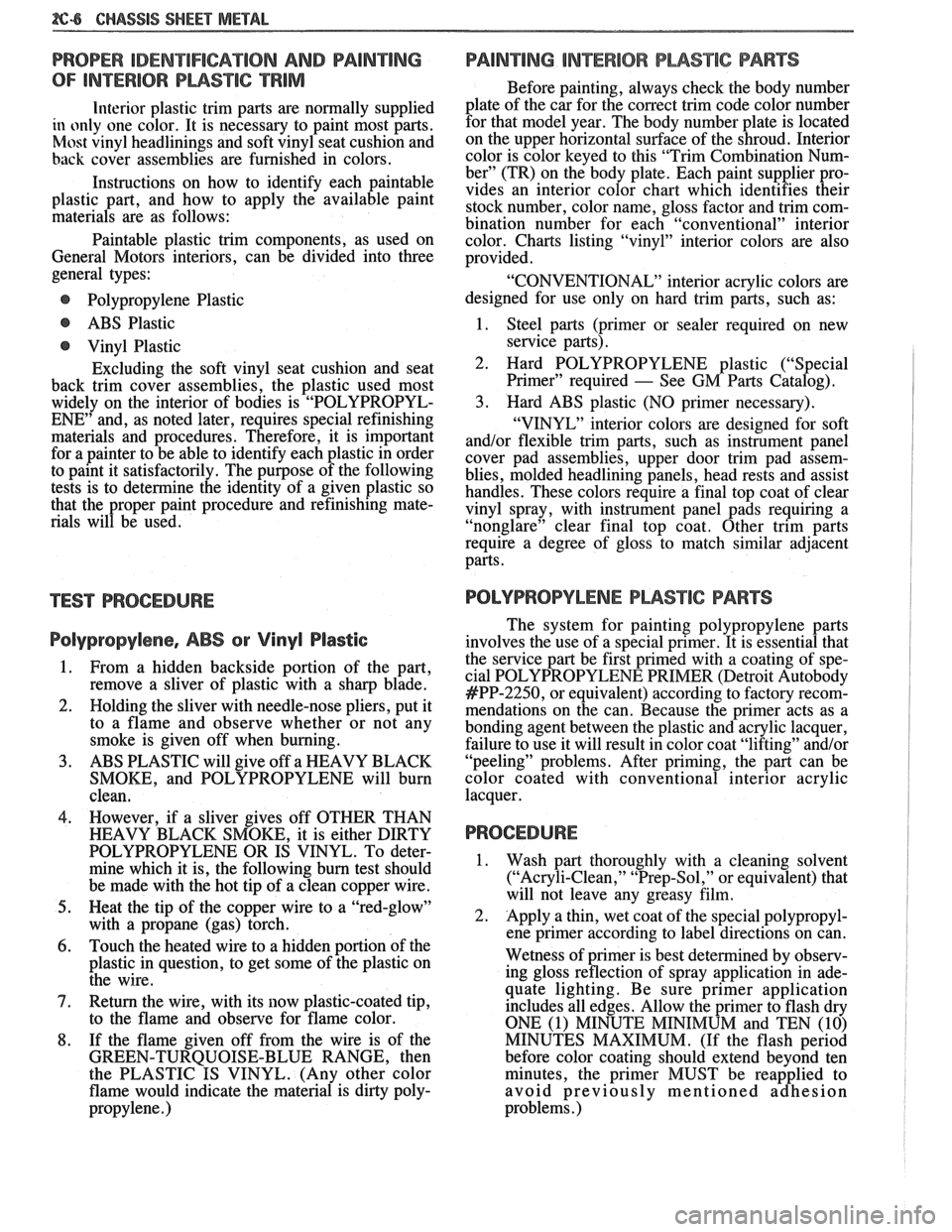
866 CHASSIS SHEET METAL
PROPER IDENTIFICATION AND CDAlrUmNG
OF INTERIOR PWSTIC TRlM
Interior plastic trim parts are normally supplied
in only one color. It is necessary to paint most parts.
Most vinyl headlinings and soft vinyl seat cushion and
hack cover assemblies are furnished in colors.
Instructions on how to identify each paintable
plastic part, and how to apply the available paint
materials are as follows:
Paintable plastic trim components, as used on
General Motors interiors, can be divided into three
general types:
@ Polypropylene Plastic
@ ABS Plastic
@ Vinyl Plastic
Excluding the soft vinyl seat cushion and seat
back trim cover assemblies, the plastic used most
widely on the interior of bodies is "POLYPROPYL-
ENE" and, as noted later, requires special refinishing
materials and procedures. Therefore, it is important
for a painter to be able to identify each plastic in order
to paint it satisfactorily. The purpose of the following
tests is to determine the identity of a given plastic so
that the proper paint procedure and refinishing mate-
rials will be used.
TEST PROCEDURE
Polypropylene, ABS or Vinyl Plastic
From a hidden backside portion of the part,
remove a sliver of plastic with a sharp blade.
Holding the sliver with needle-nose pliers, put it
to a flame and observe whether or not any
smoke is given off when burning.
ABS PLASTIC will give off a HEAVY BLACK
SMOKE, and POLYPROPYLENE will burn
clean.
However, if a sliver gives off OTHER THAN
HEAVY BLACK SMOKE, it is either DIRTY
POLYPROPYLENE OR IS VINYL. To deter-
mine which it is, the following burn test should
be made with the hot tip of a clean copper wire.
Heat the tip of the copper wire to a "red-glow"
with a propane (gas) torch.
Touch the heated wire to a hidden portion of the
plastic in question, to get some of the plastic on
the wire.
Return the wire, with its
now plastic-coated tip,
to the flame and observe for flame color.
If the flame given off from the wire is of the
GREEN-TURQUOISE-BLUE RANGE, then
the PLASTIC IS VINYL. (Any other color
flame would indicate the material is dirty poly-
propylene.
)
PAINWING lNTERiOR PWSTIC PARTS
Before painting, always check the body number
plate of the car for the
correct trim code color number
for that model year. The body number plate is located
on the upper horizontal surface of the shroud. Interior
color is color keyed to this "Trim Combination Num-
ber" (TR) on the body plate. Each paint supplier pro-
vides an interior color chart which identifies their
stock number, color name, gloss factor and trim com-
bination number for each "conventional" interior
color. Charts listing "vinyl" interior colors are also
provided.
"CONVENTIONAL" interior acrylic colors are
designed for use only on hard trim parts, such as:
1. Steel parts (primer or sealer required on new
service parts).
2. Hard POLYPROPYLENE plastic ("Special
Primer" required
- See GM Parts Catalog).
3. Hard ABS plastic (NO primer necessary).
"VINYL" interior colors are designed for soft
and/or flexible trim parts, such as instrument panel
cover pad assemblies, upper door trim pad assem-
blies, molded headlining panels, head rests and assist
handles. These colors require a final top coat of clear
vinyl spray, with instrument panel pads requiring a
"nonglare" clear final top coat. Other trim parts
require a degree of gloss to match similar adjacent
parts.
POLYPROPYLENE PUSTIC PARTS
The system for painting polypropylene parts
involves the use of a special primer. It is essential that
the service part be first primed with a coating of spe-
cial POLYPROPYLENE PRIMER (Detroit
Autobody
#PP-2250, or equivalent) according to factory recom-
mendations on the can. Because the primer acts as a
bonding agent between the plastic and acrylic lacquer, failure to use it will result in color coat "lifting"
and/or
"peeling" problems. After priming, the part can be
color coated with conventional interior acrylic
lacquer,
PROCEDURE
1. Wash part thoroughly with a cleaning solvent ("Acryli-Clean," "Prep-Sol," or equivalent) that
will not leave any greasy film.
2. Apply a thin, wet coat of the special polypropyl-
ene primer according to label directions on can.
Wetness of primer is best determined by observ-
ing gloss reflection of spray application in ade-
quate lighting. Be sure primer application
includes all edges. Allow
the primer to flash dry
ONE (1) MINUTE MINIMUM and TEN (10)
MINUTES MAXIMUM. (If the flash period
before color coating should extend beyond ten
minutes, the primer MUST be reapplied to
avoid previously mentioned adhesion
problems
.)